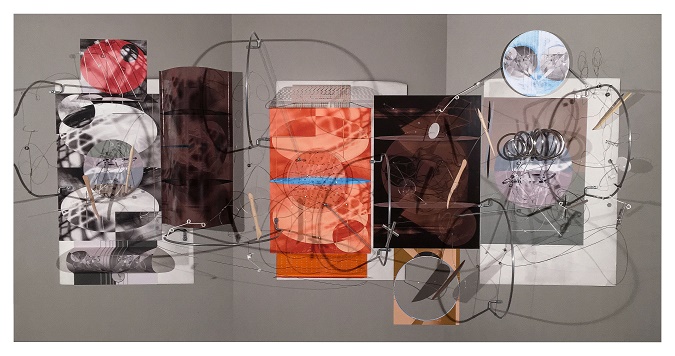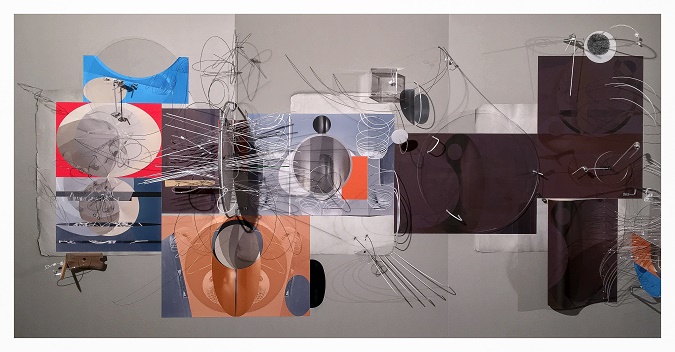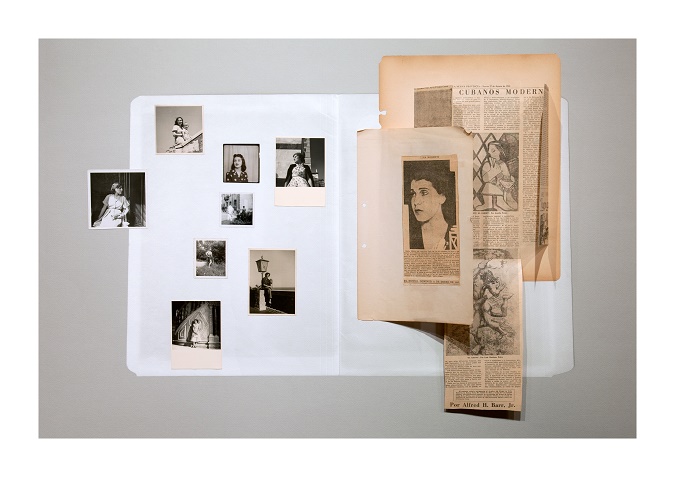As a photographer, María Martínez-Cañas pushes her medium to the edge and then some, manipulating photographic materials in highly experimental ways. Her art, with its recurring use of fragmented forms and images, has provoked comparisons to photomontages by the likes of John Heartfield and Alexander Rodchenko. The fragments revisit and reference her deep knowledge of art history, particularly in her native Cuba.
"I always try to challenge myself in the way photographic images are supposed to look," she explained to me in a February 11, 2017, interview at Fredric Snitzer Gallery, where her latest work is on view in "Rebus + Diversions" through March 6, 2017.
Born in Havana in 1960, Martínez-Cañas was brought that same year to Puerto Rico by her parents, before eventually settling in Miami. Like thousands of compatriots, her family and friends fled the island following Fidel Castro's rise to power in 1959. Raised by parents with close ties to Cuban and Latin American culture, she early displayed an acute visual sensitivity: painting as a child, meeting artists, and constantly snapping pictures with a Brownie camera. An exile's sense of displacement was integral to her artistic DNA.
Maria Martínez-Cañas has been widely recognized during a prolific career spanning nearly 40 years, with art in permanent collections of the Art Institute of Chicago, Ford Foundation, International Center of Photography, Los Angeles County Museum of Art, Smithsonian's American Art Museum, Pérez Art Museum Miami, Museum of Modern Art, and others, according to the gallery.
In "Rebus + Diversions" at Snitzer, she's clearly challenged herself. Those who've watched her career evolve over the years may be astounded, as this critic was, by the exhibit. It's a huge departure.
In the Snitzer show, the artist has ricocheted into a shocking, even grating new realm. The show brings together 20 assemblages—described as "Mixed Media on Archival Arches Aquarelle Rag Paper"—created during an intense level of activity in 2016. The work on view is by far her most aggressively three-dimensional manipulation of photographic materials and artistic techniques.
.

"Untitled 018" by María Martínez-Cañas, 2016. Mixed Media on Archival Arches Aquarelle Rag Paper, 44 x 84 inches. Courtesy Fredric Snitzer Gallery.
.
These assemblages incorporate a host of industrial objects, including silvery fiberglass mesh and coiled wire, to reiterate her signature themes of memory and loss. Those themes point to her pivotal experience as an artist who grew up in exile, with no firsthand memories of her homeland.
In this astonishing new work, she treads very close to chaos, if not violence. It is her characteristic sense of elegance that for the most part holds these tendencies in check.
In some cases, such as Untitled 020 and Untitled 019, Martínez-Cañas has physically pierced velvety images with the drop-dead precision of a military sharp shooter. Narrow metal bars penetrate and protrude from these layered surfaces. They surgically inscribe three-dimensional curves and angles echoed in the undulating "flesh" of her shadowy, layered photographic images. Primarily abstract, such imagery is embedded with formal references to the figurative and architectural forms more clearly announced in other works in the exhibit.
.

"Untitled 019" by María Martínez-Cañas, 2016. Mixed media on Archival Arches Aquarelle Rag Paper, 44 x 84 inches. Courtesy Fredric Snitzer Gallery.
.
As the title "Rebus + Diversions" suggests, the works in this series are interconnected, with playful, puzzle-like clues hinting at the similar and abruptly interrupted forms repeating in one work after another. Each work offers a lively meditation on the vagaries of memory as it looms bright, then fades into a blurry mirage.
It's an oddity of the art world that the bristling hard edges of hardware as well as the gauzy, geometric layers of photography in "Rebus + Diversions" came about thanks to the painterly legacy of the late Lee Krasner, the widow of Jackson Pollock. After Krasner's death in 1985, the Pollock-Krasner Foundation was established at her behest. To date it has awarded more than 4,100 grants in excess of $65 million to artists in 77 countries. Martínez-Cañas created these recent works with the aid of a $25,000 Photography Fellowship from the foundation.
Yet, these pieces are not the ones she initially planned to make nor what the Pollock-Krasner Foundation had first planned to fund. Intrigued by Giotto's St. Francis frescoes in Assisi, Italy, Martínez-Cañas was going to make "photographic recreations" of them, as she explained to me. But obstacles arose: photographs of the frescoes were not permitted. Available photographic reproductions didn't interest her.
With the foundation's permission, she moved forward with the new body of work in the Snitzer show, finding boundary-breaking inspiration in more recent art history close to home. Punctuating these assemblages are allusions to Cuban modernist painters, as well as to artists who have shaped her thinking about the confluence of abstract forms: Laszlo Moholy-Nagy, Gego, and Jesus Rafael Soto.
.

"Untitled 016" by María Martínez-Cañas, 2016. Mixed Media on Archival Arches Aquarelle Rag Paper, 44 x 84 inches. Courtesy Fredric Snitzer Gallery.
.
Early inspiration was a manila file folder. But this was not just any file folder. It was "a remnant," she recalled. With that word, and with that folder, Martinez-Cañas opened a bold new chapter in her career.
The folder belonged to the historic archive of the late Cuban curator, author, and critic José Gómez-Sicre, which was given to the artist by her father, a longtime art dealer in Miami. Drawing on his extensive knowledge of Latin American art, Gómez-Sicre advised Alfred H. Barr Jr. on creating the landmark exhibit "Modern Cuban Painters" for the Museum of Modern Art in 1944. That exhibit included painting by Cundo Bermudez, who, along with Gómez-Sicre, was a close friend of the Martínez-Cañas family. When she was a child, "he would watch me paint," the artist recalls. "I looked up to him as a grandfather figure."
She began photographing the contents of the archive and choosing images from it to create a personal portrait of her artistic heritage. Untitled 010 is her homage to Cundo Bermudez, with precisely layered photographs, articles, ephemera and even the scanned image of a small painting, presented as a partly hidden archival treasure. The composition invites the eye to rove among these remnants of a sparkling artistic life shadowed by exile.
.

"Untitled 010" by María Martínez-Cañas, 2016. Mixed Media on Archival Arches Aquarelle Rag Paper, 31 x 44 inches. Courtesy Fredric Snitzer Gallery.
.
The first work in the series, Untitled 001, shows an open manila file folder, to which are attached various photographs of Latin American women, as well as overlapping layers of newsprint with articles by Gómez-Sicre. Included is an obituary he wrote about Tina Modotti, with a large photo of the pioneering Mexican photographer dominant in this assemblage. Partially visible are newsprint images of paintings included in "Modern Cuban Painters."
.

"Untitled 001" by María Martínez-Cañas, 2016. Mixed Media on Archival Arches Aquarelle Rag Paper, 31 x 44 inches. Courtesy Fredric Snitzer Gallery.
.
In many cases Martínez-Canas has used actual photographs taken by Gómez-Sicre of artworks and artists, as well as other memorabilia; on other occasions she has scanned and printed them. Her own memorabilia, often printed from iPhone shots of life in Miami, adds to the cumulative effect of these mercurial compositions. Experimenting with her stash of gelatin silver print photographic paper, used thirty years ago to create a series evoking Cuban surrealist painter Wifredo Lam, she adds subtle gradations of color, from lavender and peach to silver.
The personal portrait implicit in Untitled 001 would later explode into the dynamic, sculptural compositions in this series. Yet every work is still somehow anchored to the artist's archival experience of sifting through deceptive layers of time.
______________________________
BASIC FACTS: "Rebus + Diversions" by María Martínez-Cañas is on view February 3 to March 6, 2017, at Fredric Snitzer Gallery, 1540 NE Miami Court, Miami, Florida 33132. www.snitzer.com.
______________________________
